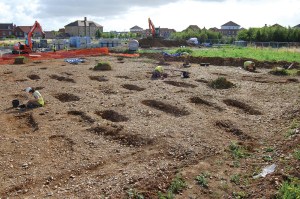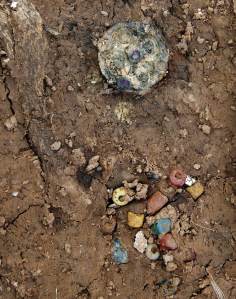Construction of a mixed retail and residential development, on an area known as ‘The Meads’, near Sittingbourne, commenced in May 2008. The site, which straddles the boundary between Sittingbourne/Milton Regis and Bobbing, had been subject to Brickearth extraction in the past, so surviving archaeology was not expected, despite an aerial photograph of 1982 which appeared to show the crop-marks of large ring ditches on the site. Consequently, a condition for a watching brief was placed on the site, which was carried out by Andy Linklater of Canterbury Archaeological Trust.
Stripping of the topsoil by GSE Ltd revealed that most of the Brickearth on the site had indeed been removed, but also that archaeological features survived cut into the underlying gravels. The first major feature located was one of the prehistoric ring ditches. Several features with corroded iron objects in their fills were also noted within the circuit of the ring ditch. As further areas were stripped, it rapidly became apparent that a major early Anglo-Saxon cemetery was also present on the site. Since construction had already commenced, there was little option other than to launch an excavation and a CAT team, led by Tania Holmes, carried this out from May to December 2008.
By the time the excavation was completed in December 2008, 227 Anglo-Saxon inhumations and 2 cremations had been excavated. The majority were inhumations, although a small number of urned cremations were also recovered. Bone preservation was very poor, with a few long bones and teeth surviving in a very fragile state; most burials contained no bone at all.
However, the majority of the inhumations did contain grave goods; over 2500 objects, including weapons, dress accessories, knives and vessels, have been recovered. Some of the graves contained considerable numbers of objects, including several rich weapon burials (almost certainly those of men) and three, female gendered, burials with garnet-inlaid brooches, including a plated disc brooch from Grave 2. Many of the graves contained sets of glass, amber or amethyst beads; there were over 300 glass beads in Grave 203 alone.
Grave 184, a weapon burial with sword, shield and spear, contained a pair of intact glass cone beakers, placed either side of the head; very appropriate for someone buried at a place called the Meads, on a part of the site that is due to become a pub!
The finds from the cemetery appear to date from around the middle of the 6th century AD through to the end of the 7th. Although some distinctively Kentish and Frankish objects, such as garnet-inlaid brooches and belt fittings, are present, there is no sign of the material culture that characterises east Kent during the late 5th or early 6th century. This may be because burial at this site had not commenced by then, or because the earliest parts of the cemetery lay beyond the limits of the excavation. Alternatively, it may be that the community using this site had yet to come within the orbit of the emerging Kentish kingdom at that stage.
The Meads represents the first modern, large-scale, excavation of an early Anglo-Saxon cemetery in the mid-Kent region (that is, between the Medway and the Stour). Most of our ideas about the nature of east Kentish cemeteries at this time come from the region south-east of the Stour, or from Thanet; the easternmost third of the county. There is very little information, for instance, on the rich cemetery at King’s Field, Faversham, other than a large collection of grave goods which suggests proximity to a high-status craft-working site from circa 540 onwards; it may be only from this period that the Swale region became fully integrated within the Kingdom of Kent. The Meads is thus a key site for our understanding of the internal development of early Anglo-Saxon Kent. One already noticeable contrast with east Kent concerns weapon burials; the majority at the Meads include shields, a pattern more typical of East Anglia than Kent east of the Stour. It will be interesting to see whether any other differences between the community at the Meads and their neighbours further east in Kent become apparent during the study of this site.
But the dead were being buried at this place long before the 6th century AD. The ring ditch was probably associated with a now vanished Bronze Age round barrow, part of several situated along the low ridge that bisects the site from north-east to south-west. The mound and central burial have not survived, although the ditch fill produced an interesting assemblage of worked flint and prehistoric pottery (as did many of the Anglo-Saxon grave fills), indicating activity on the site during the Mesolithic and Neolithic periods. A major surprise was the discovery of four Beaker vessels in a cluster of features away from the barrow. These seem to represent accessory vessels from three inhumations, along with one cremation. Other prehistoric features in this part of the site include post holes and what appears to be a segmented ditch; the latter partially encloses the area centred on the Beaker burials and has produced early prehistoric, possibly Neolithic, pottery.
Clearly, a very significant prehistoric site is present at the Meads and this is yet another place in Kent where an early Anglo-Saxon community were drawn to place their dead in proximity to early prehistoric round barrows. Analysis and publication of CAT’s excavations at the Meads will make a major contribution to the archaeology of both periods in the mid-Kent region.
ANDREW RICHARDSON
Canterbury Archaeological Trust
Images and text courtesy of Canterbury Archaeological Trust







